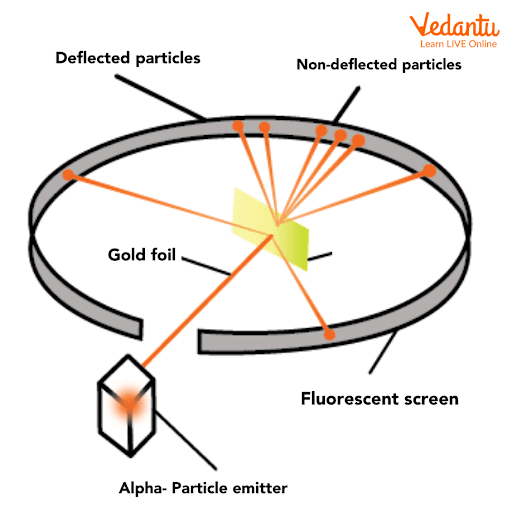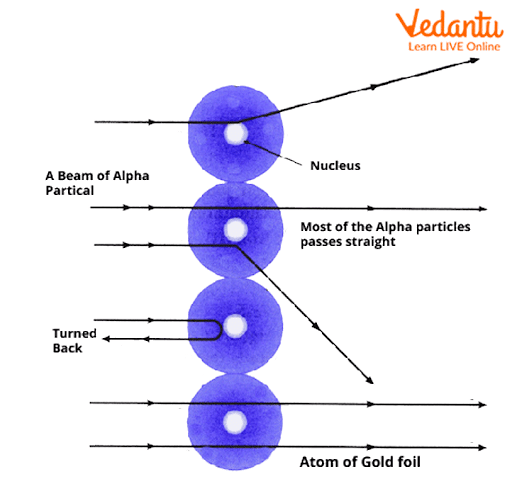




Rutherford Alpha Particle Scattering Experiment
Understanding the Rutherford Scattering Experiment is essential for solving questions related to atomic structure, scattering phenomena, and the discovery of the nucleus for JEE Main 2025. This concept forms the foundation of atomic theory, making it a crucial topic in Physics.
The Rutherford Scattering Experiment is a landmark study in atomic structure, conducted by Ernest Rutherford in 1911. In this article, we will look into the famous Rutherford scattering experiment. The experiment was performed to explain the atomic structure of elements. There are many atomic models introduced earlier before it, such as the “Plum pudding model” by British Physicist J.J. Thomson. In this model, he compared the atom to a plum pudding in which the negative charge is the dry fruits and the positive charge is spread all over. The atom is neutral with an equal number of positive and negative charges. But this model failed to explain experimental results about the atomic structure completely.
JEE Main Chemistry Syllabus JEE Main Chemistry Revision Notes JEE Main Chemistry Important Questions JEE Main Chemistry Difference Between JEE Main Chemistry Question Papers
Experimental Setup of Rutherford Alpha Scattering Experiment
The Rutherford alpha particle scattering experiment was discovered by Ernest Rutherford, a New Zealand Physicist. He was interested in studying the atomic structure and designed the scattering experiment. Rutherford is famous for his pioneering studies of radioactivity atoms other than the alpha particle scattering experiment, and he is known as the father of Nuclear Physics.
Rutherford's alpha-particle scattering experiment was a successful attempt to present an atomic model. In the experiment, Rutherford used an alpha particle emitter, gold foil, and a movable fluorescent screen proper description of the same is given below:
Gold foil: A thin sheet of gold foil with a thickness of around 100 nm.
Alpha particle emitter: A high-energy beam of α-particles (Helium ions) emitted from the radioactive source.
Movable Fluorescent screen: A zinc sulphide screen is placed around the gold foil.
The Rutherford scattering experiment diagram with proper set-up is given below:

Rutherford scattering experiment diagram
The high-energy alpha particles from the alpha-particle emitter are pointed to the gold foil through a slit. The alpha particles were bombarded on the gold foil placed before the movable zinc sulphide fluorescent screen. A fluorescent screen was used for the purpose of detecting alpha particles. Students can learn the skeleton of how to draw Rutherford scattering experiment to remember the mechanism of the concept in exams.
Observations of Rutherford Alpha Scattering Experiment
The observations after the successful execution of the Rutherford scattering experiment were:
Most of the α-particles that were bombarded on the gold foil passed through the foil with no deflection. It indicated that most of the space inside an atom is empty.
Some of the α-particles were deflected from the gold foil by small angles. This indicated that the positive charge in an atom is not uniformly distributed. This disproved the J. J. Thomson, uniformly distributed positive charges from the plum pudding model.
A very small amount of α-particles (1-2%) were deflected back from the gold foil at a nearly 180° angle. This indicated that the positive changes are concentrated in a very small volume. The size of the positively charged particles is very small as compared to the total size of the atom.
Rutherford’s Atomic Model
Based on the observations of the scattering experiment, Rutherford proposed the atomic structure of elements. According to Rutherford's atomic model:
The positively charged particles are concentrated in a very small volume as compared to the total size of the atom. Most of the atom’s mass is also concentrated in this small volume. Rutherford called this small region inside that atom a “Nucleus”.
Rutherford proposed that the negatively charged particles (electrons) are surrounded by the positively charged nucleus. The electrons move around the nucleus in a circular path at a high speed. He named the circular path of electrons “Orbit”.
The dense positively charged nucleus and surrounding negatively charged electrons are held together by a force of attraction called electrostatic forces of attraction.

Observations of the Rutherford model
Advantages of the Rutherford’s Model
This model discovered the presence of a nucleus in an atom. According to Rutherford, the nucleus is a region in an atom where entire positive charges are concentrated.
It correctly postulated that most of the atom’s mass is concentrated in the small region of the nucleus.
Rutherford postulated that the negatively charged electrons revolve around the nucleus in a circular path similar to our solar system.
Drawbacks of the Rutherford’s Model
Rutherford's model failed to explain the stability of an atom. From the calculations, the moving electron will collapse in less than
According to Maxwell's theory, charged particles in a circular motion will experience acceleration and emit electromagnetic radiation. So the moving electrons around the nucleus in an atom should emit electromagnetic radiation. The electromagnetic radiation will carry energy from the circular motion of the electron and this will lead to the shrinking of the electron's orbit. This will end the collapsing of the electron with the nucleus.
The Rutherford theory of atomic structure failed to explain the electron arrangement in an atom which was a major drawback of the model.
Significance of Rutherford Scattering Experiment in JEE Main 2025
The Rutherford Scattering Experiment is fundamental to understanding atomic structure.
It revealed the presence of a dense, positively charged nucleus at the center of the atom, disproving earlier atomic models like Thomson’s plum pudding model.
This discovery paved the way for the nuclear model of the atom, explaining concepts like atomic mass, charge distribution, and the behaviour of alpha particles during collisions.
Questions based on the Rutherford Scattering Experiment appear frequently in the Atomic Structure section, with 1-2 questions in most JEE Main papers.
These questions often focus on the experiment's observations, conclusions, or mathematical derivations related to scattering angles and particle deflection, making it a vital topic for scoring well in Physics.
Tips for JEE Main 2025 preparation
Know the Syllabus: Focus on high-weightage topics in Physics.
Make a Study Plan: Allocate time for concept building, practice, and revision.
Strengthen Basics: Use NCERT textbooks to build a strong foundation.
Practise Regularly: Solve past papers and take topic-wise mock tests.
Time Management: Learn to balance time between subjects and questions.
Revise Often: Maintain short notes and revise formulas frequently.
Use Quality Resources: Refer to trusted books and platforms like Vedantu for guidance.
Mock Tests: Take weekly mock tests and work on weak areas.
Consistency: Stick to your plan and maintain discipline.
Self-Care: Get enough rest, eat healthily, and stay positive.
Conclusion
In the Rutherford alpha particle scattering experiment, alpha particles were bombarded with gold foil. The scattering of alpha particles by gold foil was observed with the fluorescent sheet of zinc sulphide and observations were noted. The groundbreaking observations were noted in the Rutherford atomic model. The Rutherford atomic model was able to explain a lot of theories that the previous Thomson’s plum pudding model failed to explain. Although Rutherford's model explained a lot of theories, it failed to explain the stability and electron arrangement in an atom.
JEE Main 2025 Subject-Wise Important Chapters
The JEE Main 2025 subject-wise important chapters provide a focused strategy for Chemistry, Physics, and Maths. These chapters help students prioritise their preparation, ensuring they cover high-weightage topics for better performance in the exam.
Check Other Important Links for JEE Main and JEE Advanced 2025
JEE 2025 needs well-structured study materials. Here are some valuable resources to help you plan your preparation and practice efficiently.
FAQs on Learn About Rutherford Scattering Experiment: JEE Main 2025
1. What is Rutherford Scattering Experiment?
The Rutherford Scattering Experiment was conducted by Ernest Rutherford to study the deflection of alpha particles by a thin gold foil, leading to the discovery of the atomic nucleus.
2. What is Rutherford alpha particle scattering experiment?
The Rutherford alpha particle scattering experiment involved directing alpha particles at a thin gold foil to observe their deflection patterns, revealing the presence of a dense, positively charged nucleus.
3. How is the Rutherford scattering experiment diagram drawn?
The diagram of the Rutherford scattering experiment includes an alpha particle source, a thin gold foil, a circular screen to detect particle deflections, and observed paths of scattered particles.
4. Can you explain Rutherford scattering experiment in detail?
The Rutherford scattering experiment showed that most alpha particles pass through the foil, some are deflected at small angles, and a few bounce back, indicating a small, dense nucleus.
5. How to draw Rutherford scattering experiment diagram for exams like JEE Main 2025?
To draw the diagram, include a source of alpha particles, a gold foil in the centre, a circular fluorescent screen to detect deflections, and paths for undeflected and deflected particles.
6. What are Rutherford alpha scattering experiment observations?
Observations include most alpha particles passing through without deflection, some deflecting at small angles, and a few bouncing back, indicating the presence of a dense nucleus.
7. Does Vedantu provide a Rutherford scattering experiment PDF for JEE Main 2025?
Yes, Vedantu provides a FREE PDF on Rutherford’s scattering experiment, including detailed explanations, diagrams, and solved questions, tailored for JEE Main 2025 preparation.
8. What conclusions were drawn from Rutherford scattering experiment?
The experiment concluded that the atom has a small, dense, positively charged nucleus surrounded by electrons, with most of the atom being empty space.
9. What is the significance of Rutherford alpha particle scattering experiment in JEE Main?
It is significant for understanding atomic structure, the discovery of the nucleus, and foundational concepts in scattering, frequently tested in the Atomic Structure section of JEE Main.
10. What are the key takeaways from Rutherford scattering experiment for NEET and JEE Main?
Key takeaways include the discovery of the nucleus, understanding the distribution of mass and charge in an atom, and insights into atomic structure, vital for NEET and JEE Main exams.
























